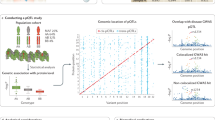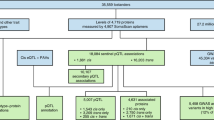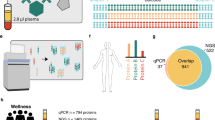Abstract
The plasma proteome is one of the most important proteomes from a diagnostic standpoint, as quantitative changes between normal and diseased states can be used to discover novel biomarkers for clinical diagnosis and therapeutic monitoring of diseases. HUPO’s Plasma Proteome Project has involved characterization of the plasma proteome by an international consortium using technologies ranging from antibody arrays to mass spectrometry and has helped in the construction of a substantial catalog of plasma proteins. Our group has developed the Plasma Proteome Database (http://www.plasmaproteomedatabase.org) as a comprehensive resource of annotated data for posttranslational modifications, single-nucleotide polymorphisms, tissue expression, subcellular localization, and disease involvement of plasma proteins. This database should serve to facilitate further research to help understand the plasma proteome in health and disease.
Access this chapter
Tax calculation will be finalised at checkout
Purchases are for personal use only
Preview
Unable to display preview. Download preview PDF.
Similar content being viewed by others
References
Putnam FW. In: Putnam FW, ed. The Plasma Proteins: Structure, Function, and Genetic Control. New York, Academic Press, 1975–1987:1–55.
Anderson NL, Anderson NG. The human plasma proteome: history, character, and diagnostic prospects. Mol Cell Proteomics 2002; 11:845–867.
Qian WJ, Jacobs JM, Camp DG 2nd, et al. Comparative proteome analyses of human plasma following in vivo lipopolysaccharide administration using multidimensional separations coupled with tandem mass spectrometry. Proteomics 2005;5:572–584.
Ping P, Vondriska TM, Creighton CJ, et al. A functional annotation of subproteomes in human plasma. Proteomics 2005;5:3506–3519.
Rai AJ, Gelfand CA, Haywood BC, et al. HUPO Plasma Proteome Project specimen collection and handling: towards the standardization of parameters for plasma proteome samples. Proteomics 2005;5:3262–3277.
Omenn GS, States DJ, Adamski M, et al. Overview of the HUPO Plasma Proteome Project: results from the pilot phase with 35 collaborating laboratories and multiple analytical groups, generating a core dataset of 3020 proteins and a publicly-available database. Proteomics 2005;5:3226–3245.
Muthusamy B, Hanumanthu G, Suresh S, et al. Plasma Proteome Database as a resource for proteomics research. Proteomics 2005;5:3531–3536.
Martens L, Hermjakob H, Jones P, et al. PRIDE: the proteomics identifications database. Proteomics 2005;5:3537–3545.
Deutsch EW, Eng JK, Zhang H, et al. Human Plasma PeptideAtlas. Proteomics 2005;5:3497–3500.
Chan KC, Lucas DA, Hise D, et al. Analysis of the human serum proteome. Clin Proteomics 2004;1:101–225.
Anderson NL, Polanski M, Pieper R, et al. the human plasma proteome: a nonredundant list developed by combination of four separate sources. Mol Cell Proteomics 2004;3:311–326.
Shen Y, Jacobs JM, Camp DG, et al. Ultra-high-efficiency strong cation exchange LC/RPLC/MS/MS for high dynamic range characterization of the human plasma proteome. Anal Chem 2004;76:1134–1144.
Adamski M, Blackwell T, Menon R, et al. Data management and preliminary data analysis in the pilot phase of the HUPO Plasma Proteome Project. Proteomics 2005;5:3246–3261.
Peri S, Navarro JD, Amanchy R, et al. Development of human protein reference database as an initial platform for approaching systems biology in humans. Genome Res 2003;13:2363–2371.
Hanash S. Building a foundation for the human proteome: the role of the Human Proteome Organization. J Proteome Res 2004;3:197–199.
Schonberger J, Wang L, Shin JT, et al. Mutation in the transcriptional coactivator EYA4 causes dilated cardiomyopathy and sensorineural hearing loss. Nat Genet 2005;37:418–422.
Allen PG. Functional consequences of disulfide bond formation in gelsolin. FEBS Lett 1997;401:89–94.
Author information
Authors and Affiliations
Editor information
Editors and Affiliations
Rights and permissions
Copyright information
© 2007 Humana Press Inc., Totowa, NJ
About this chapter
Cite this chapter
Sarker, M., Hanumanthu, G., Pandey, A. (2007). Plasma Proteome Database. In: Thongboonkerd, V. (eds) Proteomics of Human Body Fluids. Humana Press. https://doi.org/10.1007/978-1-59745-432-2_6
Download citation
DOI: https://doi.org/10.1007/978-1-59745-432-2_6
Publisher Name: Humana Press
Print ISBN: 978-1-58829-657-3
Online ISBN: 978-1-59745-432-2
eBook Packages: Biomedical and Life SciencesBiomedical and Life Sciences (R0)




